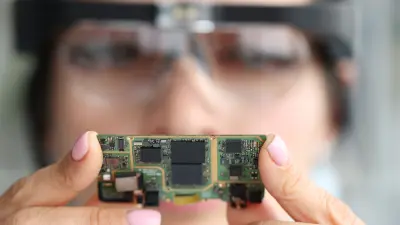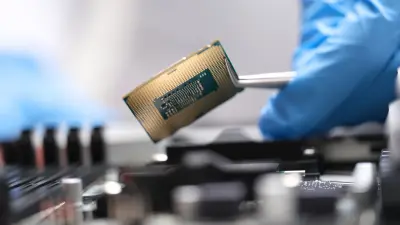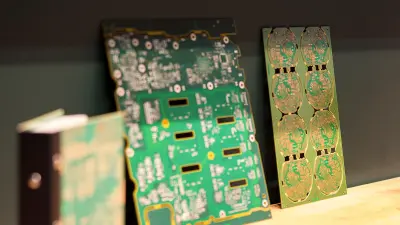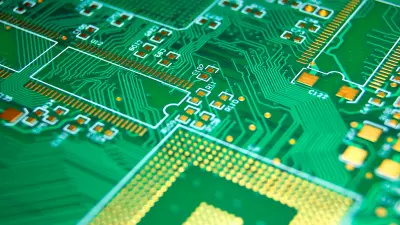The future of High-Density Interconnect (HDI) PCBs

At Bosch, we know that High Density Interconnect (HDI) Printed Circuit Boards (PCBs) are essential for businesses operating at the forefront of electronics innovation. As enterprises seek to deliver more compact, reliable, and high-performance solutions to demanding markets, HDI PCBs are becoming a strategic differentiator. This blog article examines the drivers behind the continued rise of HDI PCBs and highlights how artificial intelligence (AI) is accelerating this evolution.
HDI PCBs: strategic value for B2B enterprises
HDI PCBs offer unique advantages that directly address the needs of the electronics market, enabling them to meet stringent performance and reliability standards:
- Scalability for complex projects: HDI technology supports multi-layer, high-density designs, enabling OEMs and Tier-1 companies to integrate more functionality into smaller footprints.
- Enhanced reliability: reduced layer counts and optimized stack-ups can improve long-term product reliability, reducing warranty costs and strengthening supplier reputations.
- Faster time-to-market: streamlined manufacturing processes and AI-driven design tools may accelerate prototyping and mass production, supporting rapid deployment in fast-moving industries.

Market forces driving HDI adoption
Several key market trends and technological demands are driving the accelerated adoption of HDI PCBs across diverse sectors such as automotive, communications, medical or industrial.
1. Demand for advanced product integration
B2B clients in e.g. telecommunications, automotive, medical, and industrial automation require PCBs that can handle high-speed data, power management, and signal integrity – all within constrained spaces.
- Miniaturization: enables integration of more features in end products, supporting innovation in sectors like IoT, 5G infrastructure, autonomous systems, or medical devices such as implantable sensors.
- High-speed data transmission: essential for next-generation networking equipment and industrial controls.
2. AI as a catalyst for innovation
AI is reshaping the landscape of electronics businesses in several ways. Both design and manufacturing processes of HDI printed circuit boards, may unlock new efficiencies and capabilities.
- AI-driven design automation: machine learning-powered EDA tools optimize trace routing, via placement, and thermal management, reducing design cycles and minimizing errors.
- Process optimization: artificial intelligence can enhance quality control and predictive maintenance in PCB manufacturing, increasing yield and reducing operational costs.
- Enabling smart solutions: AI-powered products – such as industrial robotics, medical diagnostics, and connected vehicles – depend on the high-density, high-reliability interconnects that usually only HDI PCBs can provide.

The business impact: why our customers invest in HDI

Standard rigid PCB or HDI? Often that is the question we hear when we speak with customers. The following 3 key factors may help you decide between the two technologies. You may also read more about the specific advantages and requirements of rigid circuits and high-density interconnect boards on our portfolio pages.
Crucial factors of HDI PCBs and their impact and importance for AI applications
| Key factor | Impact on HDI PCBs | Relevance to AI applications |
|---|---|---|
|
Key factor
Miniaturization
|
Impact on HDI PCBs
Enables compact, high-performance devices
|
Relevance to AI applications
Essential for e.g. AI-powered wearables or medical devices
|
|
Key factor
Signal integrity
|
Impact on HDI PCBs
Supports high-speed, low-noise data transmission
|
Relevance to AI applications
Critical for AI in 5G/edge devices
|
|
Key factor
Manufacturing precision
|
Impact on HDI PCBs
Achieved via reliable process control
|
Relevance to AI applications
Increases yield and reliability
|
Conclusion

The convergence of HDI technology and AI is creating new opportunities for enterprises to lead in their respective markets. Investing in advanced HDI printed circuit board solutions positions your business to deliver innovative, reliable, and scalable products that meet the evolving needs of your customers.
Are you ready to open the full potential of HDI PCBs for your projects with Bosch? Connect with our team of experts to discuss tailored solutions and gain a competitive edge in the rapidly advancing electronics landscape.
Are you ready to open the full potential of HDI PCBs for your projects? Connect with our team of experts to discuss tailored solutions and gain a competitive edge in the rapidly advancing electronics landscape.




